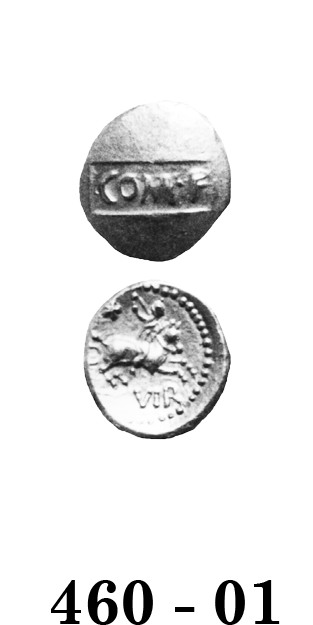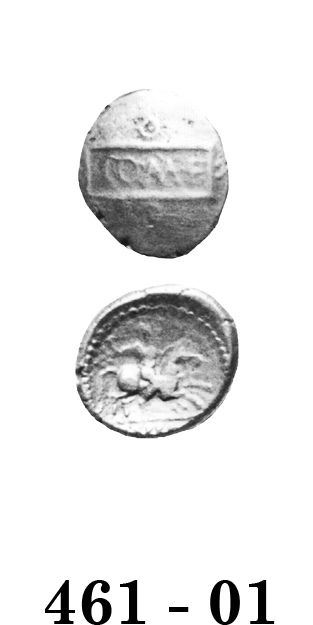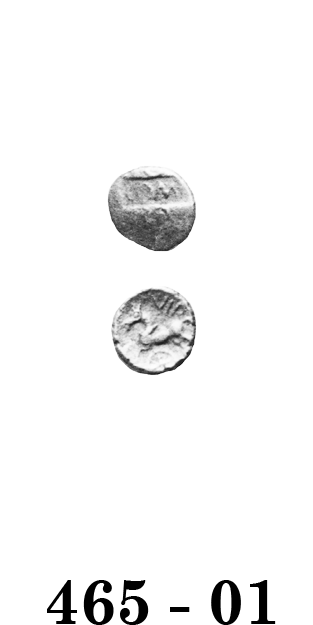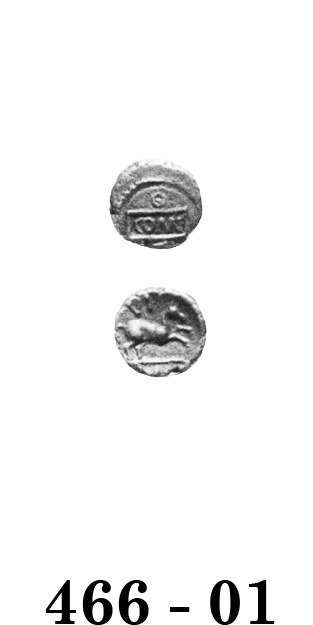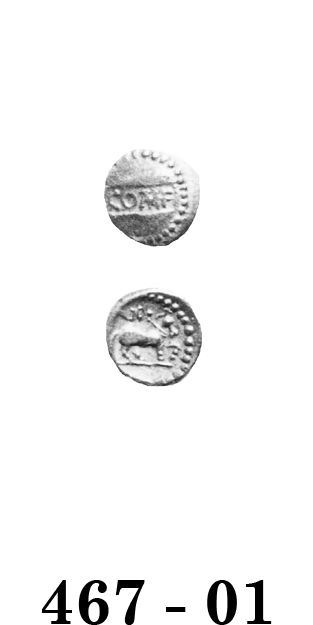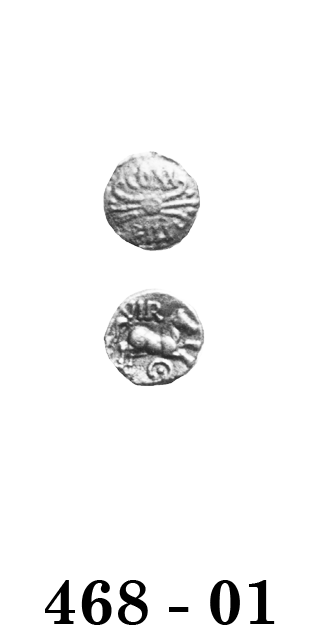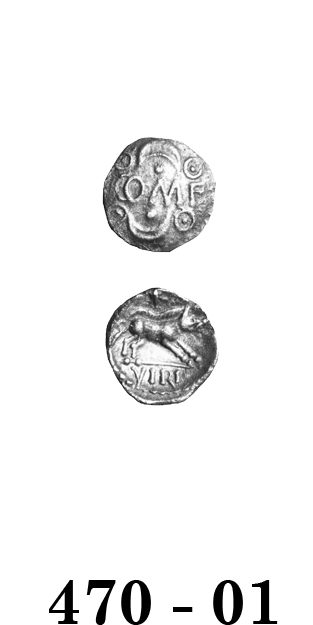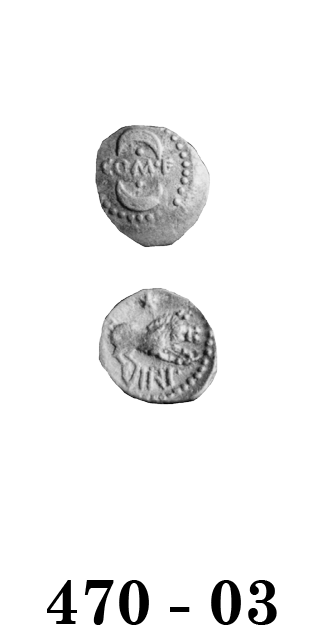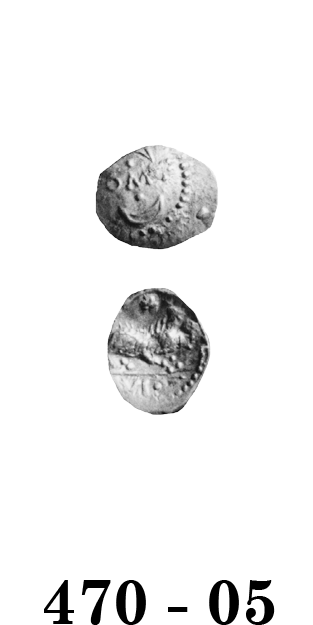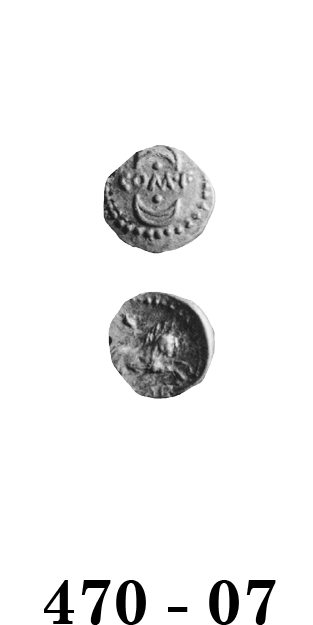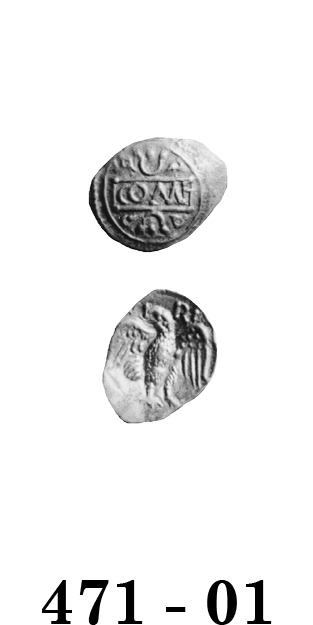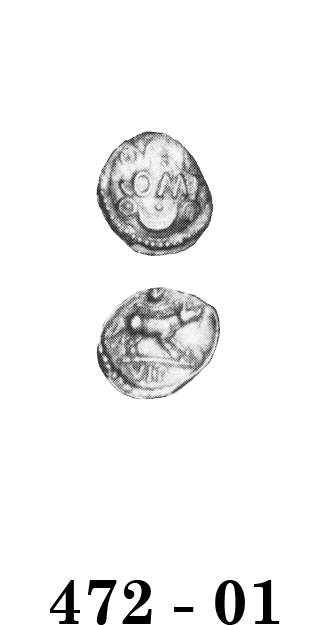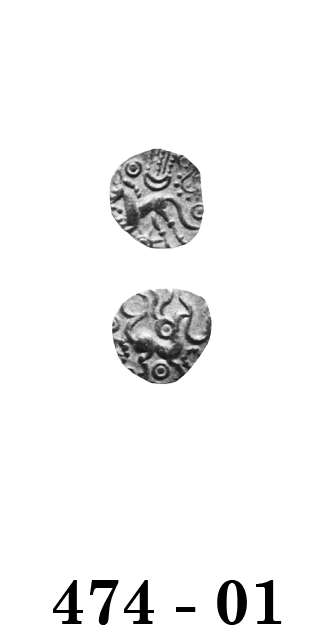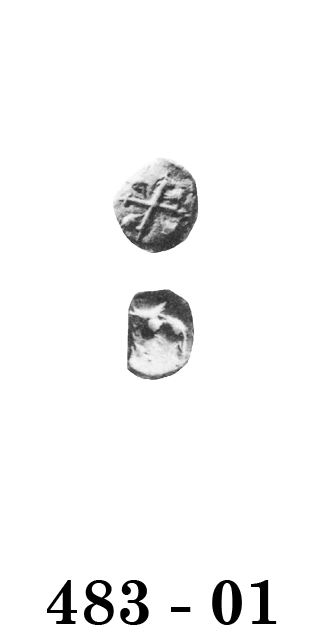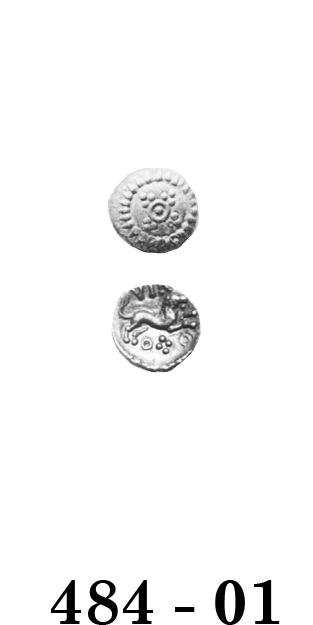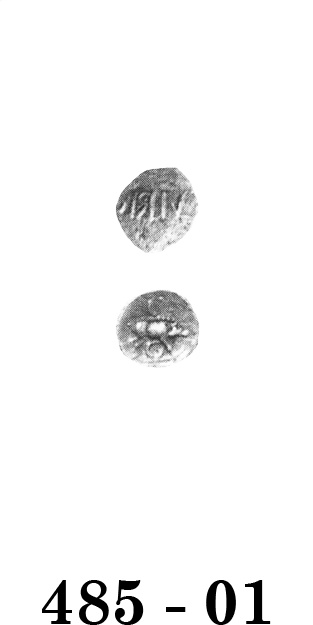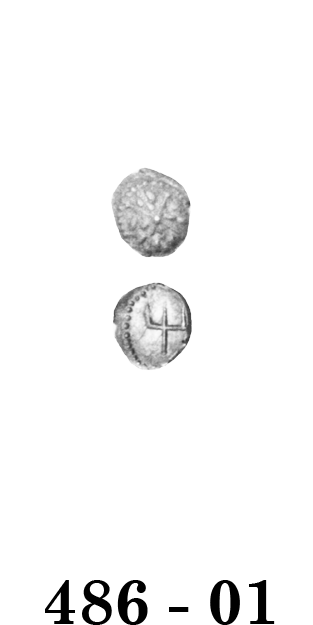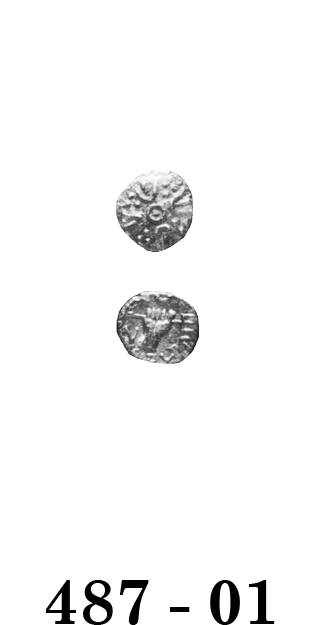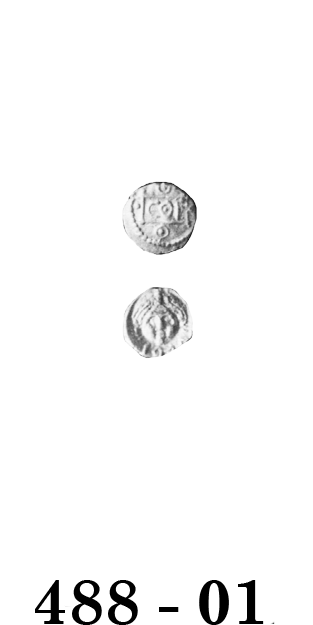
Celtic Coinage of Britain
third edition
Click on coin to see hidden information
The Coinage of Verica
Verica replaced Eppillus as leader of Atrebates around 10 A.D. Cunobeline, after his accession to the Trinovantian/Catuvellaunian leadership, had driven Eppillus and the Atrebates from Kent. Once Eppillus was deposed – he disappeared completely – peace was restored between the tribes.
Initially, Verica must have been accepted by his more powerful neighbour. By the mid 30's however, he evidently lost the support of Cunobeline. Coins began to appear in the northern part of Atrebatic territory carrying the name Epaticcus, who styled himself a son of Tasciovanus. This leader, a Trinovantian/Catuvellaunian sympathizer if not actually a relative of Cunobeline's, soon expanded his influence in Verica's territory. Verica was ultimately deposed by the encroacher and undoubtedly was the Berikos who fled to Rome on the eve of 43 A.D. Verica's appeal for Roman military intervention prompted the Claudian invasion the following year.
Verica struck three successive coinages, distinguished by the types of the staters. The First Coinage staters show a tablet with COMF on the obverse and a mounted warrior with the inscription VIR on the reverse. The Second Coinage staters are almost identical, but add the title REX to the reverse. The third coinage introduces a new design to the obverse, a vine leaf with VI RI on the sides. All three coinages include quarter staters, silver units and silver minims. No bronze coins have been identified and it is likely Verica struck only gold and silver.
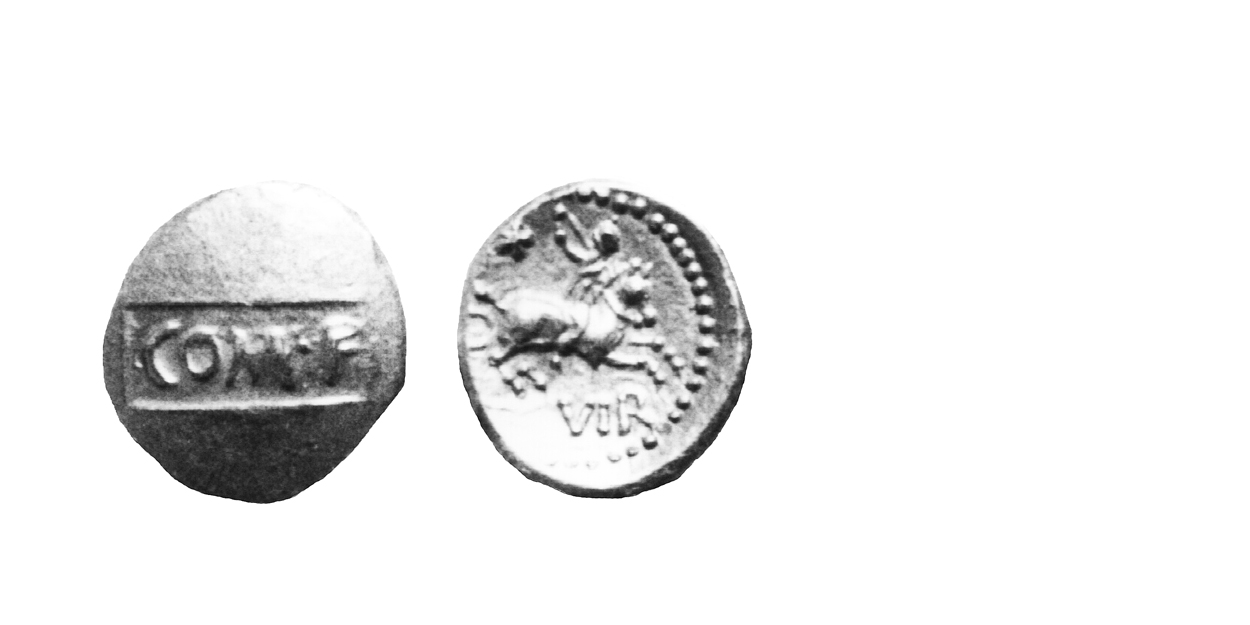
460 - 01 Verica First Coinage
10-20 A.D. Extremely Rare
Gold Stater 5.40 gms. 16 mm
Earliest Record: Evans, 1864
OBV: Inscription in Tablet
Identifying points:
1) COMF in incuse tablet
2) plain field
REV: Celtic warrior on horse right
Identifying points:
1) warrior holds spear
2) VIR below horse
3) five-pointed star above horse
4) ring behind horse
5) pellet border
CLASSIFICATION: Atrebatic I
NOTES:
- Standard weight given
- Reverse adapted from a denarius of P. Crepusius
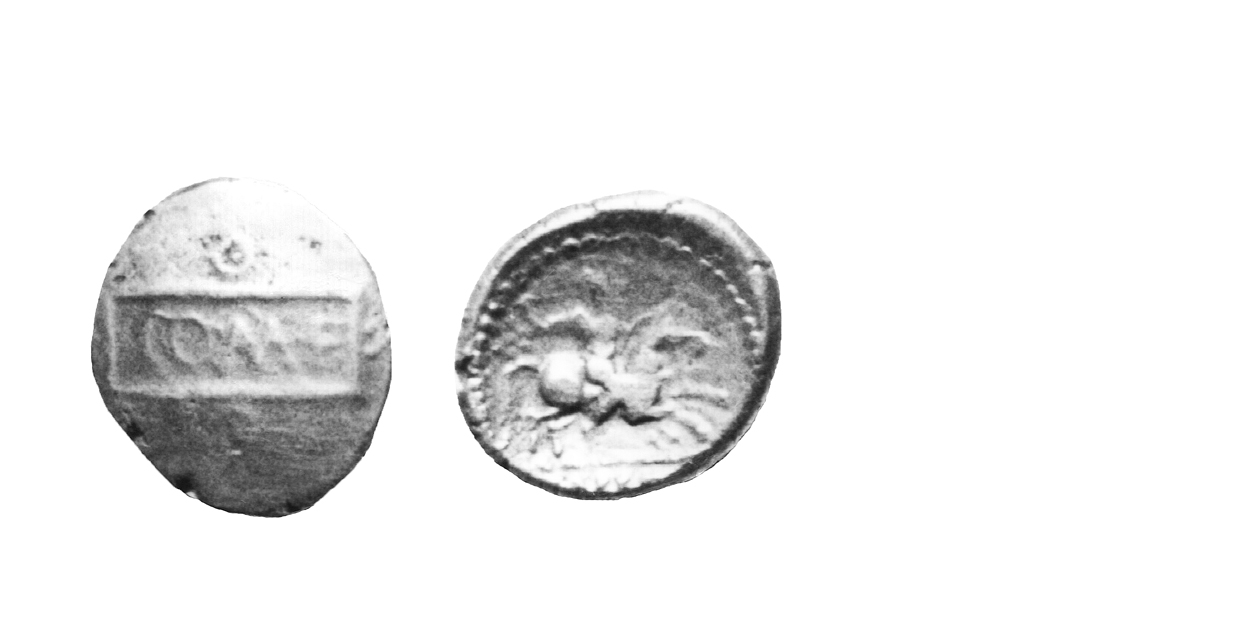
461 - 01 Verica First Coinage
10-20 A.D. Extremely Rare
Gold Stater 5.40 gms. 17 mm
Earliest record: Evans, 1864
OBV: Inscription in Tablet
Identifying points:
1) similar to 460 - 01
2) pellet-in-ring motif above and below tablet
REV: Celtic warrior on horse right
Identifying points:
1) similar to 460 - 01
2) daisy behind horse
3) exergual line below horse
4) VIR below exergual line
5) pellet border
CLASSIFlCATION: Atrebatic I
NOTES:
- Standard weight given
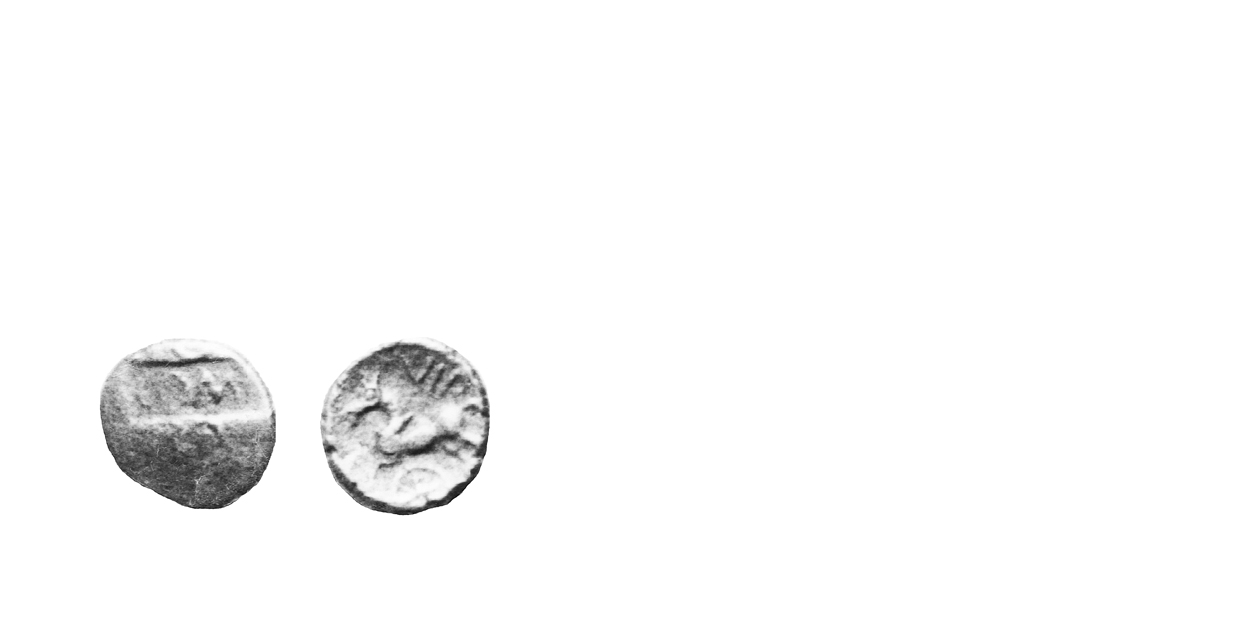
465 - 01 Verica First Coinage
10-20 A.D Extremely Rare
Gold Quarter Stater 1.0 gms. 8 mm
Earliest Record: Evans, 1890
OBV: Inscription in tablet
Identifying points:
1) COMF in incuse tablet
2) solid crescent above and below
REV: Celticized horse left
Identifying points:
1) VIR above horse
2) eight-spoked wheel below horse
CLASSIFICATION: Atrebatic I
NOTES:
- Typical weight given
- Most in museums
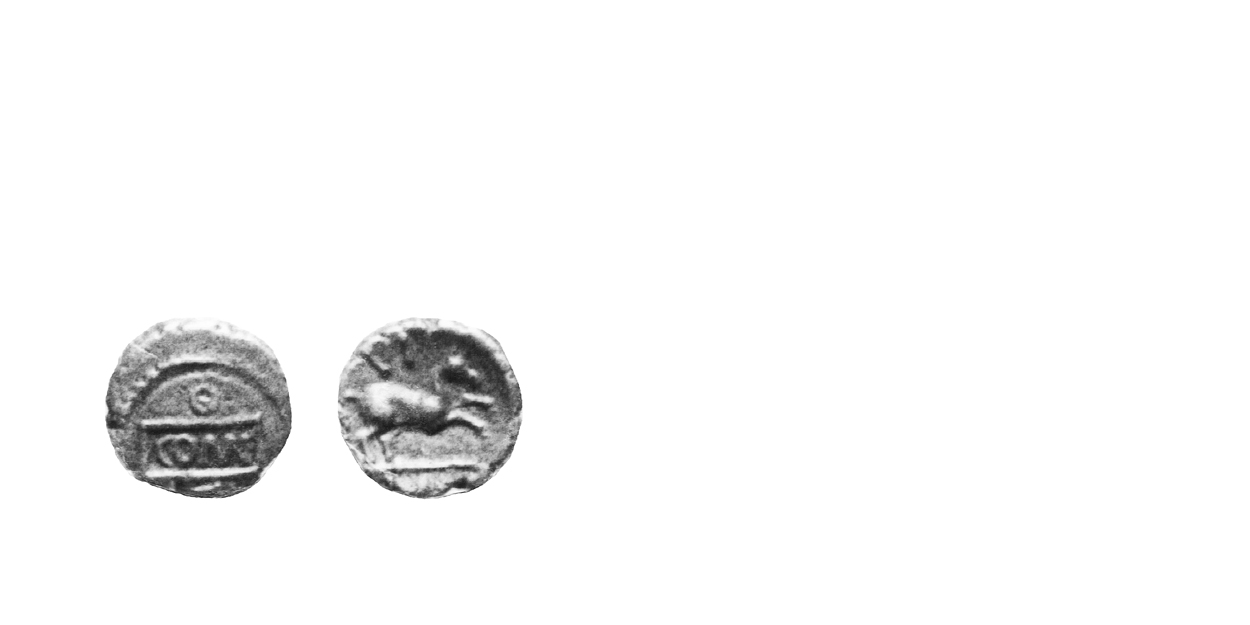
466 - 01 Verica First Coinage
10-20 A.D. Scarce
Gold Quarter Stater 1.2 gms. 9 mm
Earliest record: Poste, 1846
OBV: Inscription in tablet
Identifying points:
1) COM F in tablet
2) pellet border
REV: Celticized horse right
Identifying points:
1) horse rears on back legs
2) exergual line
3) VI above horse
4) pellet border
CLASSIFICATION: Atrebatic I
NOTES:
- Typical weight given
- Celtic Coin Index records indicate rarer than thought
- Many found at Wanborough
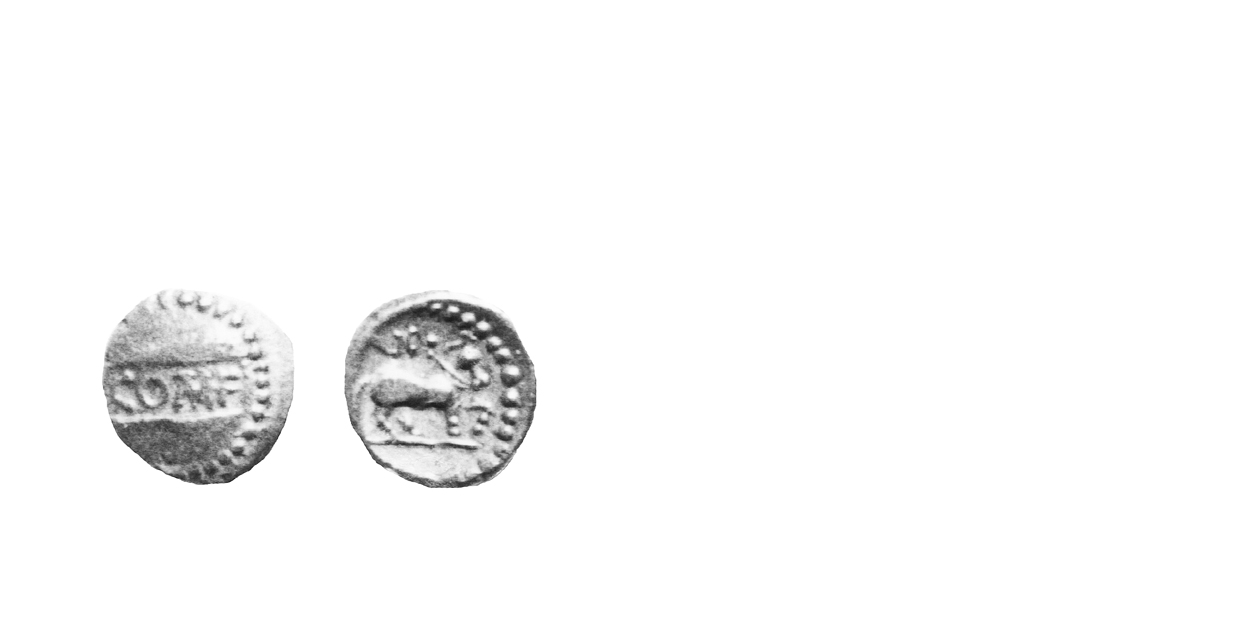
467 - 01 Verica First Coinage
10-20 A.D. Very Rare
Gold Quarter Stater 1.2 gms. 10 mm
Earliest Record: Evans, 1864
OBV: Inscription in tablet
Identifying points:
1) COMF in incuse tablet
2) pellet border
REV: Celticized horse right
Identifying points:
1) horse stands on exergual line
2) Vl above
3) horse's left front leg raised
4) pellet border
CLASSIFICATION: Atrebatic I
NOTES:
- Typical weight given
- Celtic Coin Index records indicate rarer than thought
- Many found at Wanborough
- Modern forgery exist: see – (467 - 01 - 1F)
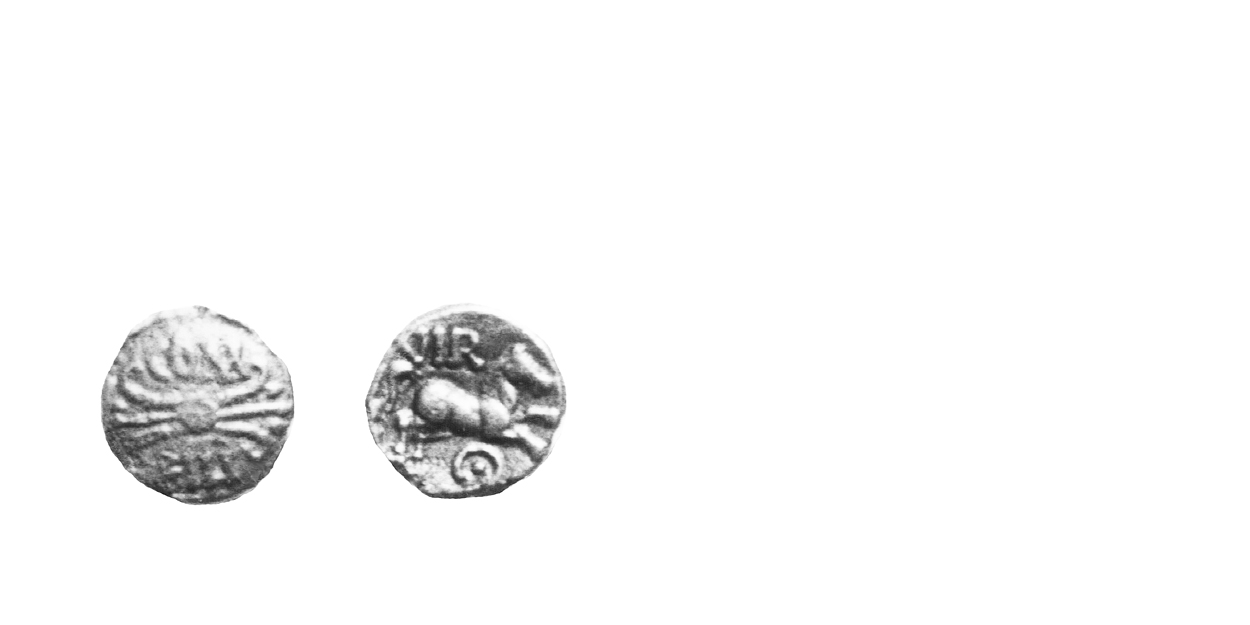
468 - 01 Verica First Coinage
10-20 A .D. Very Rare
Gold Quarter Stater 1.3 gms. 10 mm
Earliest Record: Evans, 1890
OBV: Inscription and scroll pattern
Identifying points:
1) pellet-in-ring motif in centre
2) horizontal line runs to right and left from pellet-in-ring motif
3) two curved lines run right and left from pellet-in-ring motif
4) COM above
5) FILI below
6) pellet border
REV: Celticized horse right
Identifying points:
1) VIR above horse
2) pellet-in-ring motif below horse
3) pellet border
CLASSIFICATION: Atrebatic I
NOTES:
- Typical weight given
- Many found at Wanborough
- Celtic Coin Index records indicate rarer than originally thought
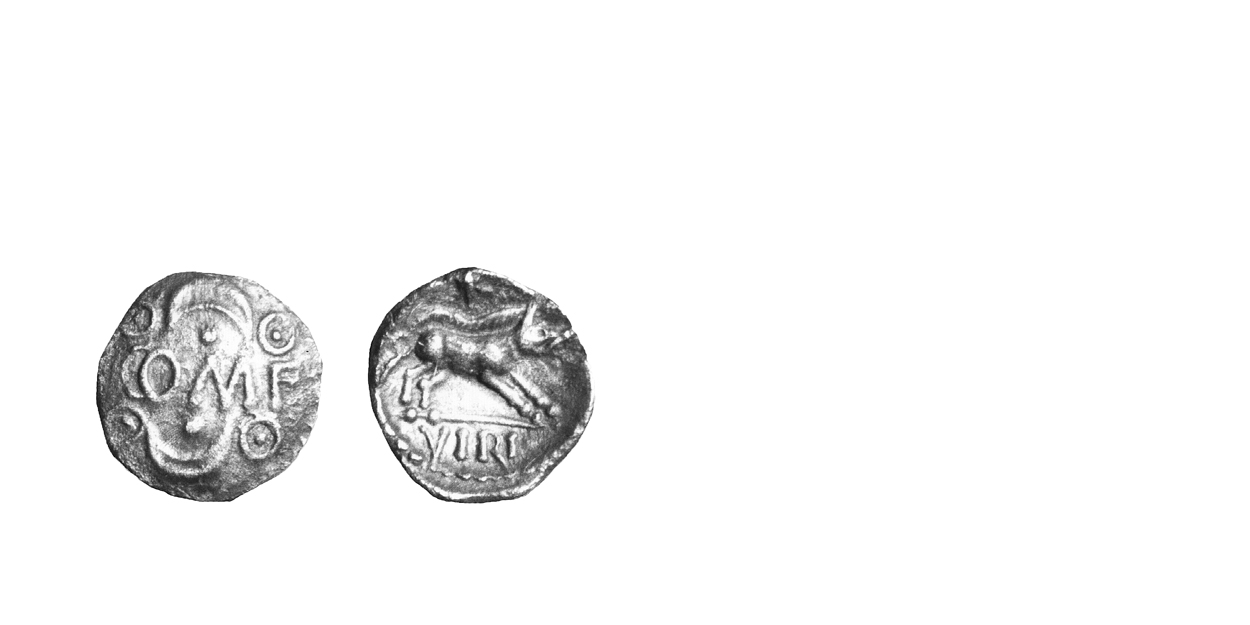
470 - 01 Verica First Coinage
10-20 A.D. Common
Silver Unit 1.2 gms. 12 mm
Earliest Record: Poste, 1853
OBV: Inscription in scroll pattern
Identifying points:
1) COMF in centre
2) outline crescent and two pellet-in-ring motifs above and below COMF
3) pellet border
REV: Boar right
Identifying points:
1) boar stands on exergual line
2) VIRI below exergual line
3) six-pointed star above boar
CLASSIFICATION: Atrebatic I
NOTES:
- Many found at Wanborough
- Reverse adapted from a denarius of M. Voteius
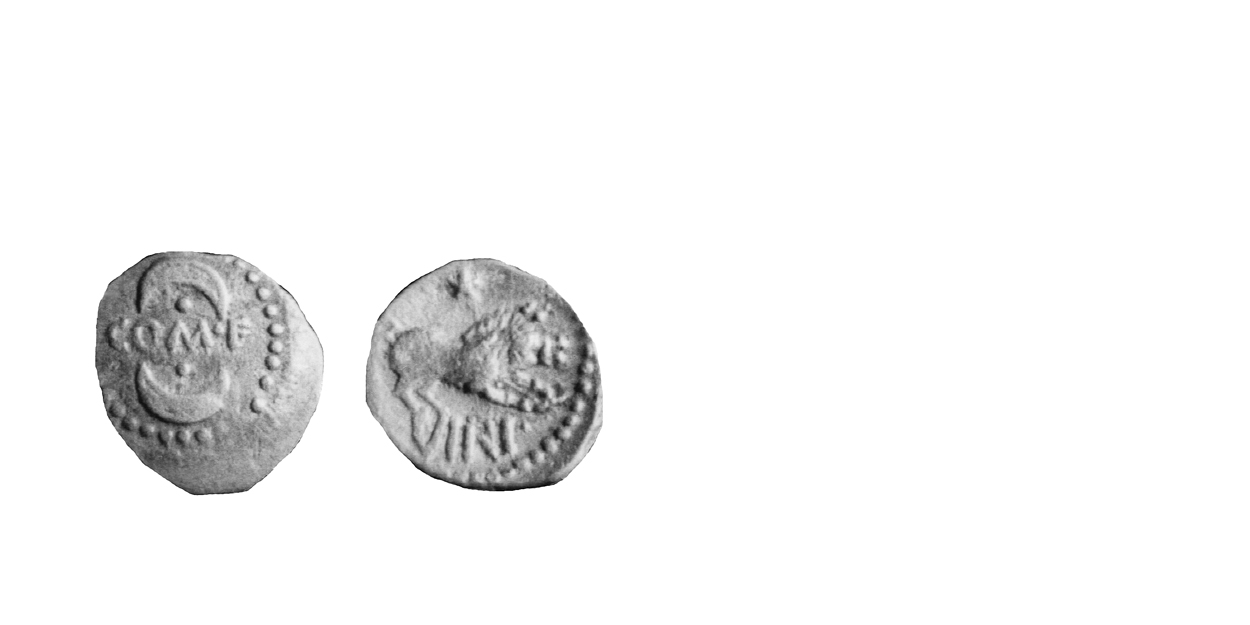
470 - 03 Verica First Coinage
10-20 A.D. Very Rare
Silver Unit 1.2 gms. 12 mm
Earliest Record: Van Arsdell, 1989
OBV: Inscription in scroll pattern
Identifying points:
1) as 470 - 01, but no pellet-in-ring motifs
REV: Boar right
Identifying points:
1) no exergual line
2) VIRI below boar
3) six-pointed star above boar
CLASSIFICATION: Atrebatic I
NOTES:
- Many found at Wanborough
- Reverse adapted from a denarius of M. Voteius
- Celtic coin Index records indicate rarer than thought
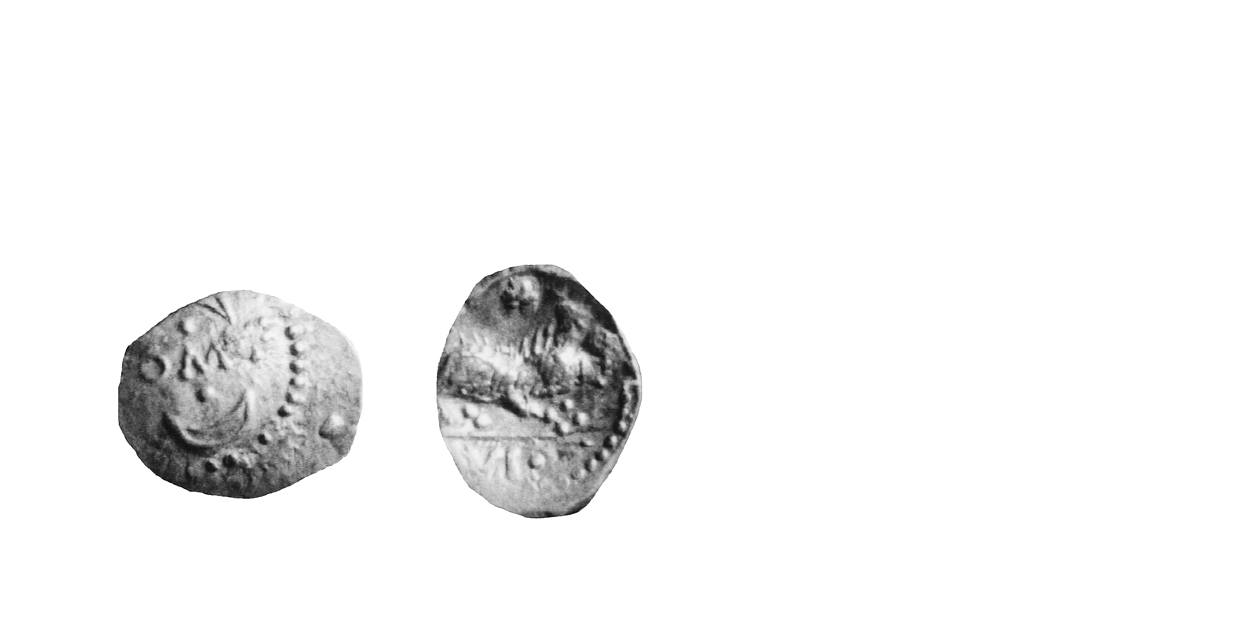
470 - 05 Verica First Coinage
10-20 A.D. Very Rare
Silver Unit 1.2 gms. 13 mm
Earliest Record: Van Arsdell, 1989
OBV: Inscription in scroll pattern
Identifying points:
1) as 470 - 03
REV: Boar right
Identifying points:
1) boar stands on exergual line
2) VI and pellet below exergual line
3) six-pointed star above boar
CLASSIFICATION: Atrebatic I
NOTES:
- Many found at Wanborough
- Celtic Coin Index records indicate rarer than thought
- Reverse adapted from a denarius of M. Voteius
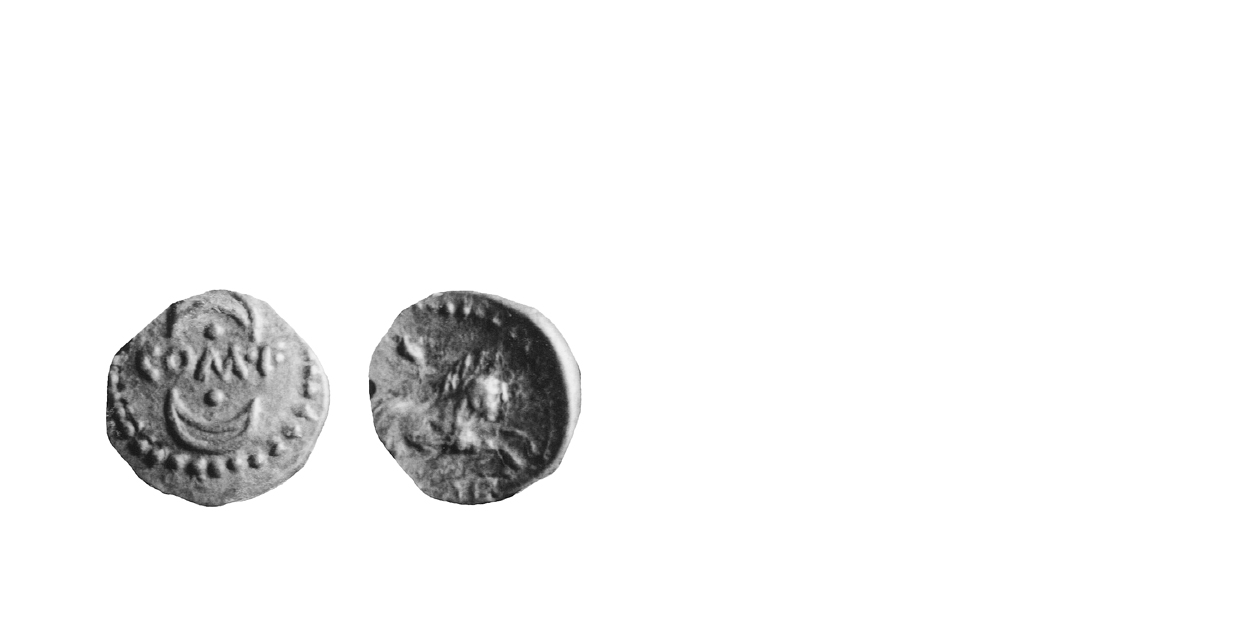
470 - 07 Verica First Coinage
10-20 A.D. Extremely Rare
Silver Unit 1.2 gms. 12 mm
Earliest Record: Van Arsdell, 1989
OBV: Inscription in scroll pattern
Identifying points:
1) as 470 - 03
REV: Boar right
Identifying points:
1) as 470 - 03, but VIR below boar
CLASSIFICATION: Atrebatic I
NOTES:
- Many found at Wanborough
- Celtic Coin Index records indicate rarer than thought
- Reverse adapted from a denarius of M. Voteius
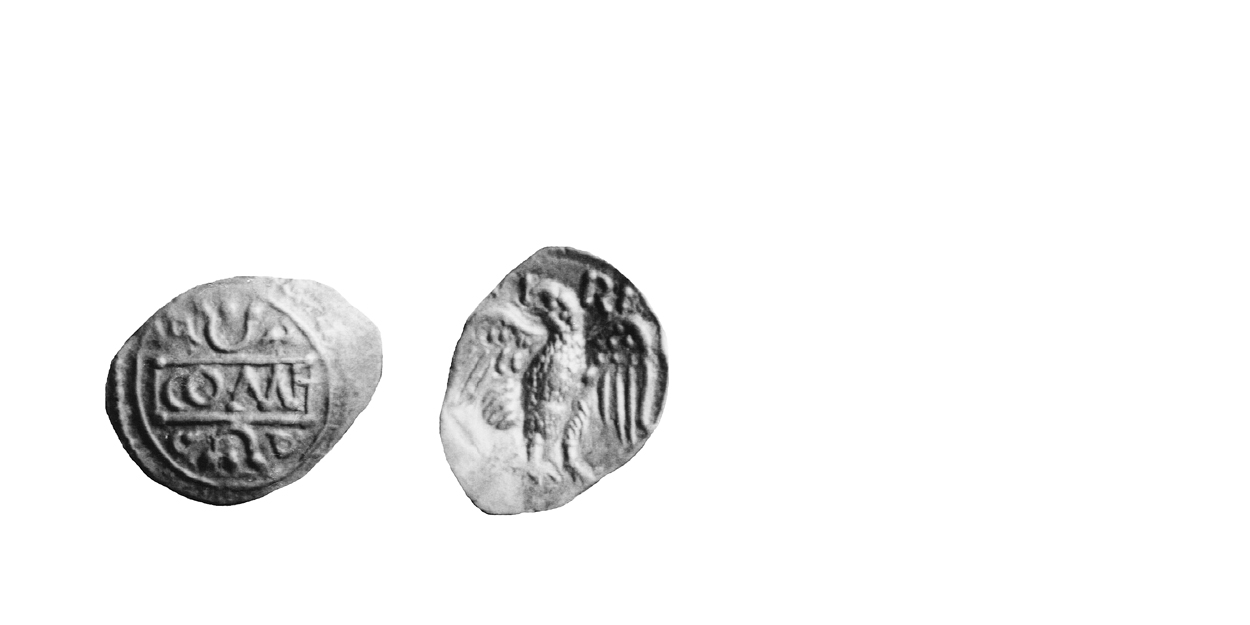
471 - 01 Verica First Coinage
10-20 A.D. Scarce
Silver Unit 0.6-1.0 gms. 12 mm
Earliest Record: Van Arsdell, 1989
OBV: Inscription in tablet and scroll
Identifying points:
1) COMF in tablet
2) solid crescent with pellet and two rings above and below tablet
3) large circle around entire image
4) pellet border outside circle
REV: Eagle
Identifying points:
1) eagle faces with wings spread
2) head turned left
3) pellet border
4) VI RT above eagle
CLASSIFICATION: Atrebatic I
NOTES:
- Many found at Wanborough
- Celtic Coin Index records indicate rarer than originally thought
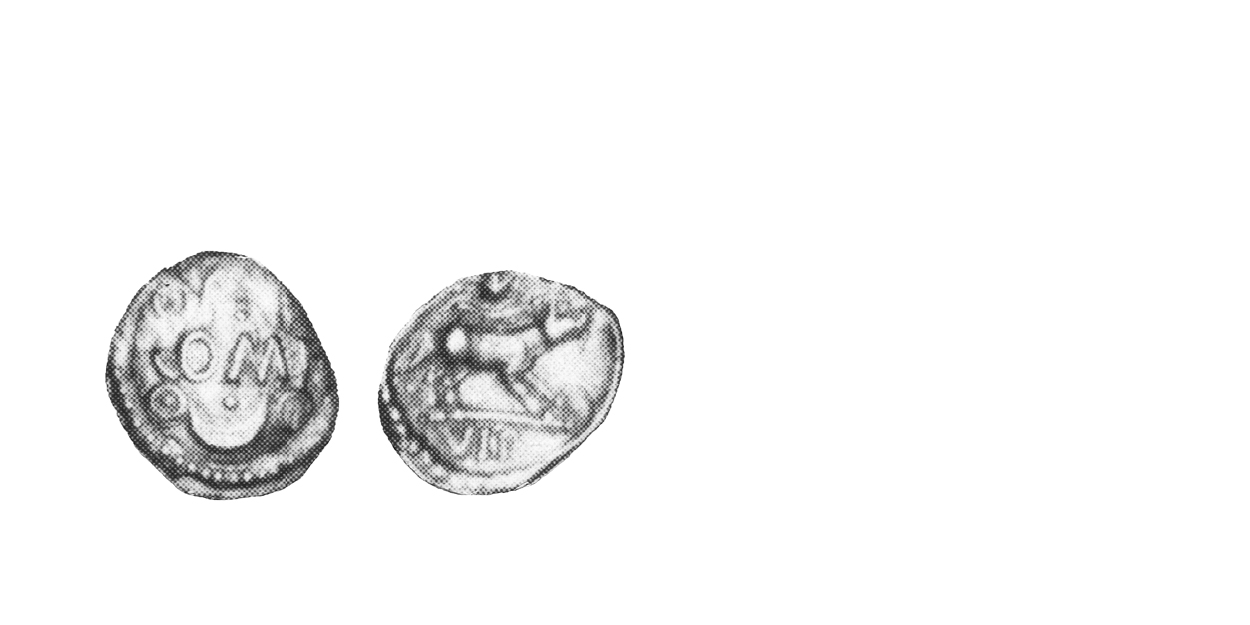
472 - 01 Verica First Coinage
10-20 A.D. Rare
Silver Unit 13 mm
Earliest Record: Van Arsdell, 1989
OBV: Inscription in scroll pattern
Identifying points:
1) COMF in centre
2) pellet above and below COMF
3) outline crescent with two pellet-in-ring motifs above and below COMF
4) pellet border
REV: Bull right
Identifying points:
1) bull stands on exergual line
2) VIR below exergual line
3) pellet border
CLASSIFICATION: Atrebatic I
NOTES:
- Some found at Wanborough
- Rarity provided by trade survey
473-01 now reattributed as 369-01
A better-preserved example now shows the obverse legend is TINC.
Go to 369-01
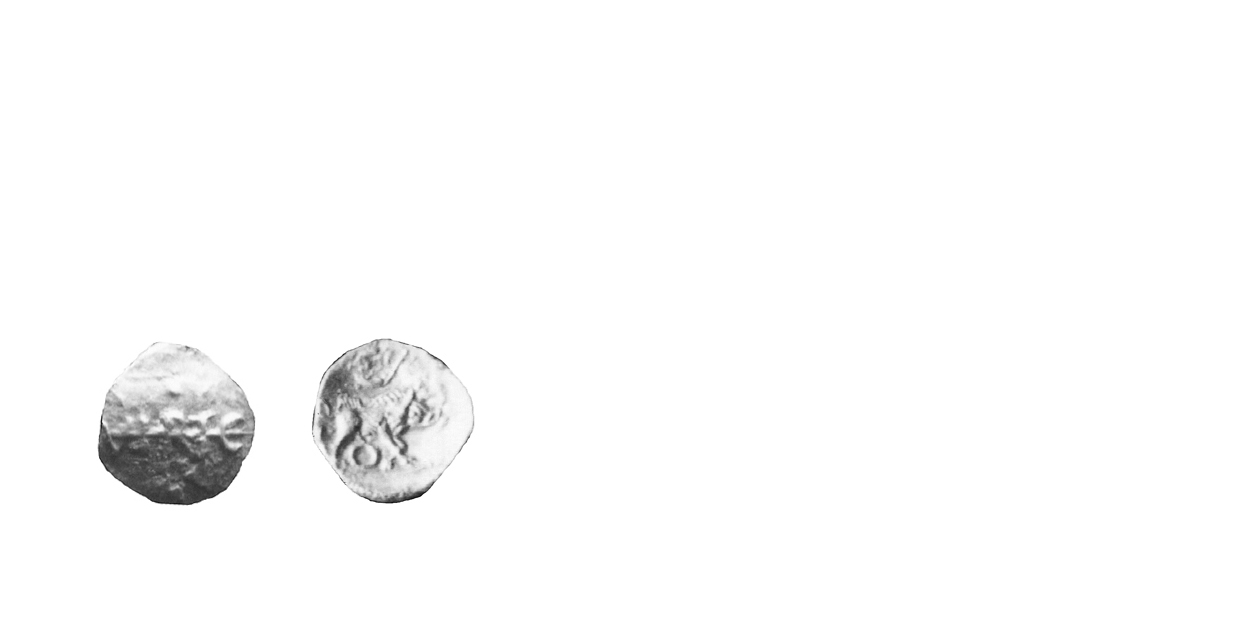
475 - 01 Verica First Coinage
10 B.C. - 10 A.D. Extremely Rare
Silver Minim 8 mm
Earliest Record: Van Arsdell, 1989
OBV: Legend in blank field
Identifying points:
1) VERICA
REV: Boar right
Identifying points:
1) ring below boar
2) boar stands on exergual line
3) uncertain object above boar
CLASSIFICATION: Atrebatic I
NOTES:
- Some found at Wanborough, may be commoner than indicated
- Previously, this coin was attributed to Eppillus (423 - 01) but a better-preserved example now shows the obverse has the legend VERICA
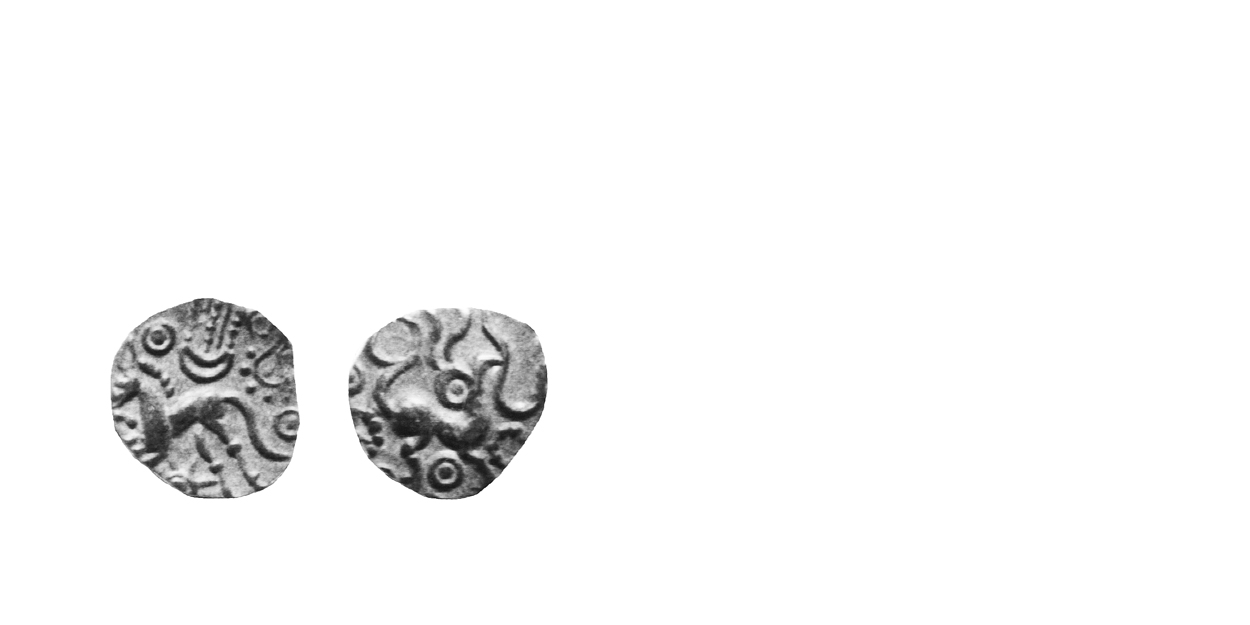
474 - 01 Problematic Type Requires Reattribution
10-20 A.D. Very Rare
Silver Unit 0.5 gms. 11 mm
Earliest Record: Evans, 1864
OBV: Celticized horse left
Identifying points:
1) pellet-in-ring motifs around horse
2) anemone behind horse
3) outline crescent above horse with lines and pellets rising from it
REV: Celticized horse right
Identifying points:
1) horse highly stylized
2) pellet-in-ring motifs around horse
3) two wavy lines rise above pellet-in-ring motif above horse
CLASSIFICATION: Not Classified
NOTES:
- Some in museums
- Traditionally described as North Thames Type LX14 by Allen, but reattributed in 1989 to Verica in the first edition of Celtic Coinage of Britain.
- Stylistically, the type is related to 369 - 01 (previously 473 - 01), a coin now attibuted to Tincomarus based on a clear reading of the inscription on a better-preserved coin. One design element the two types have in common is the crescent-with-lines above the horse.
- However, the majority of the reported findspots have been north of the Thames, with few south of the river. Finds in hoards may distort the perception in this case.
- On the basis of findspots, the type would be assigned to the Trinovantes/Catuvellauni; but on the basis of imagery, it should be a coin of Tincomarus and thus Atrebatic/Regnan/Belgic.
- Clearly an earlier type and not a coin of Verica it deserves additional study before it can be attributed properly.
- The type clearly highlights the problem of Findspot vs. Imagery as a determinant of attribution – there is no clear-cut reason why one should be considered more important than the other.
- The coin has been retained here until the matter is resolved.
482-01 now reattributed as 293-01
Initially, Evans associated this coin with some silver types of Verica. But it has long been thought possibly an earlier type. Simon Bean has reasonably assigned it to the period just before Commius.
Go to 293 - 01
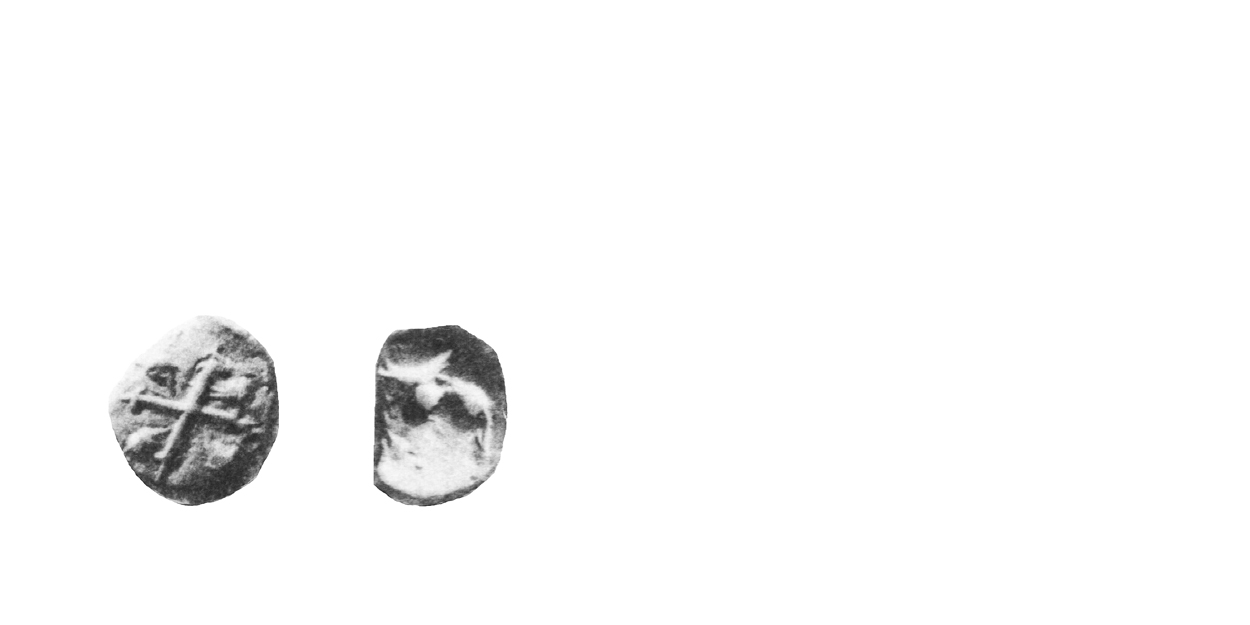
483 - 01 Verica First Coinage
10-20 A.D. Very Rare
Silver Minim 0.3 gms. 9 mm
Earliest Record: Evans, 1864
OBV: Cross
Identifying points:
1) irregular objects in angles
REV: Irregular object
Identifying points:
1) possibly an animal, object has irregular outline
CLASSIFICATION: Atrebatic I
NOTES:
- Some in museums
- Published example poorly preserved, images not clear, but type is different from other minims
- Rarity provided via trade survey has been confirmed by Celtic Coin Index records
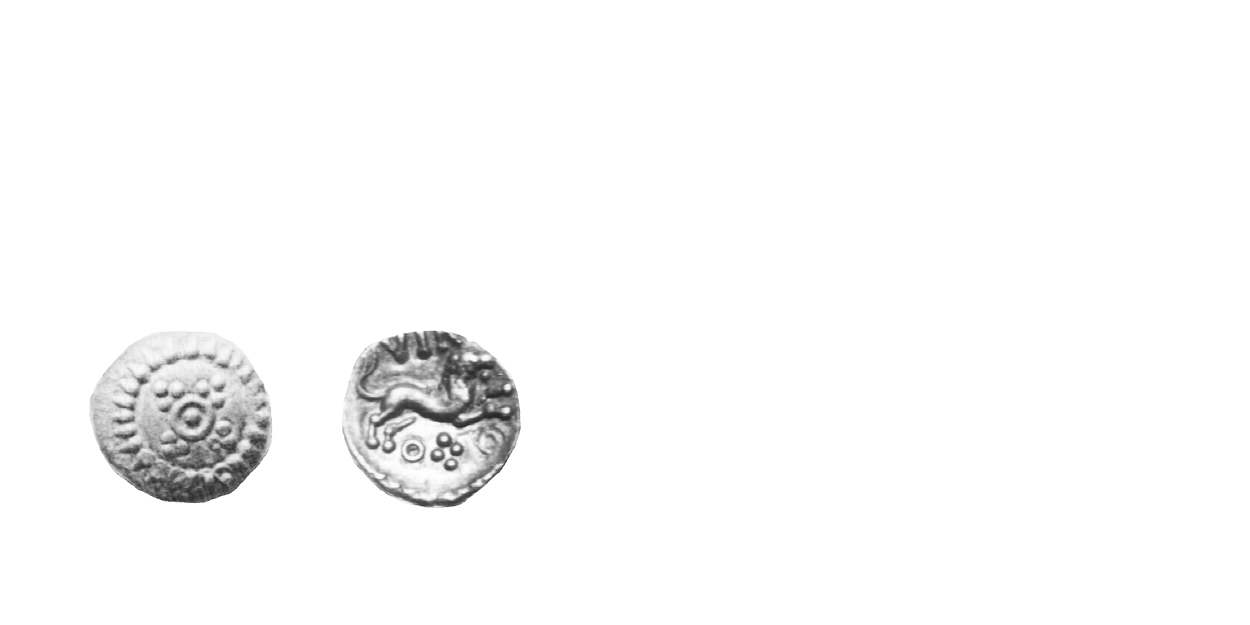
484 - 01 Verica First Coinage
10-20 A.D. Extremely Rare
Silver Minim 9 mm
Earliest Record: Mack, 1975
OBV: Pellet and ring pattern
Identifying points:
1) pellet-in-ring motif in centre
2) four groups of three pellets around central pellet-in-ring motif
3) pellet border
REV: Celticized horse right
Identifying points:
1) VIR above horse
2) pellet-in-ring motif below horse
CLASSIFICATION: Atrebatic I
NOTES:
- Most in museums
- Mack listed type twice as M120a and 120c to illustrate more of image
- Reports of many finds at Wanborough
- Celtic Coin Index records indicate rarer than originally thought
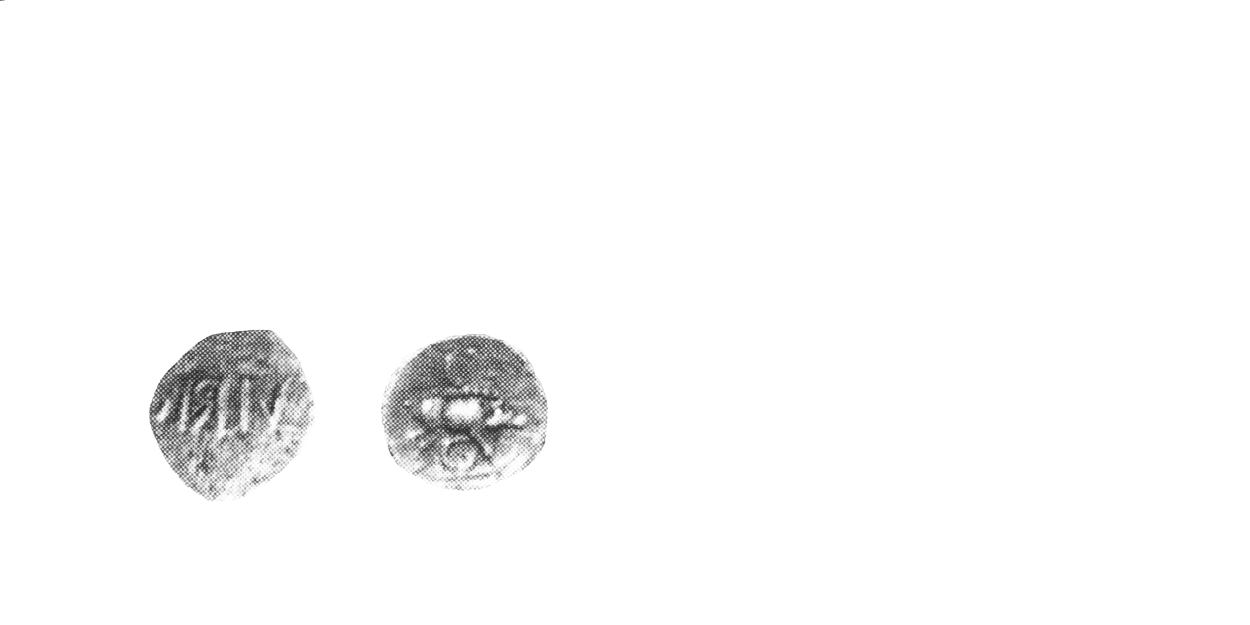
485 - 01 Verica First Coinage
10-20 A.D. Very Rare
Silver Minim 0.3 gms. 9 mm
Earliest Record: Van Arsdell, 1989
OBV: Inscription in plain field
Identifying points:
1) VIRIC in mirror-image
REV: Boar right
Identifying points:
1) C above boar
2) O below boar
3) pellet border
CLASSIFICATION: Atrebatic I
NOTES:
- Some found at Wanborough
- New variety has not been analyzed metallurgically, but type appears genuine
- Rarity provided via trade survey
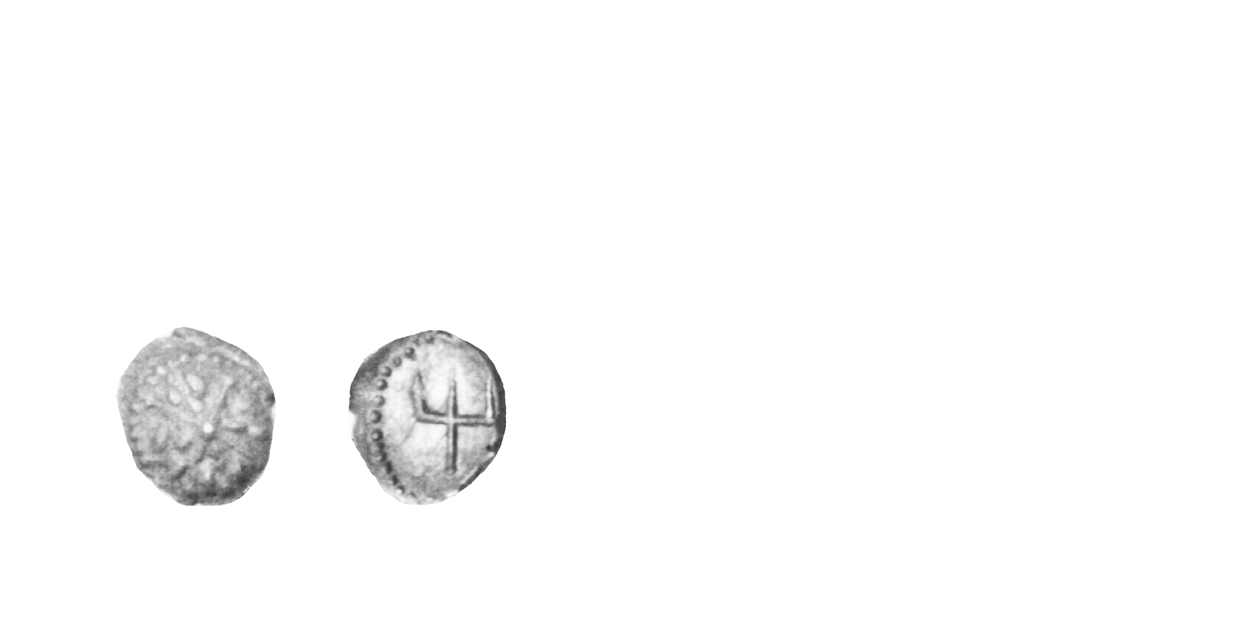
486 - 01 Verica First Coinage
10-20 A.D. Extremely Rare
Silver Minim 7 mm
Earliest Record: Allen, 1958 (1941 West Harting excavation find)
OBV: Cross and floral pattern
Identifying points:
1) two lines form cross
2) three pellets in each angle
3) pellet border
REV: Trident
Identifying points:
1) trident in plain field
2) pellet border
CLASSIFICATION: Atrebatic I
NOTES:
- This coin, first shown to Derek Allen in the British Museum during the Second World War, was reported in his 1958 PPS article as a find during excavations at West Harting, Sussex in 1941. The coin (or another example) reappeared in New York City in September, 1986.
- Reports of many finds at Wanborough
- Trade survey in late 1980s indicated Very Rare, but Celtic Coin Index records indicate rarer than originally thought
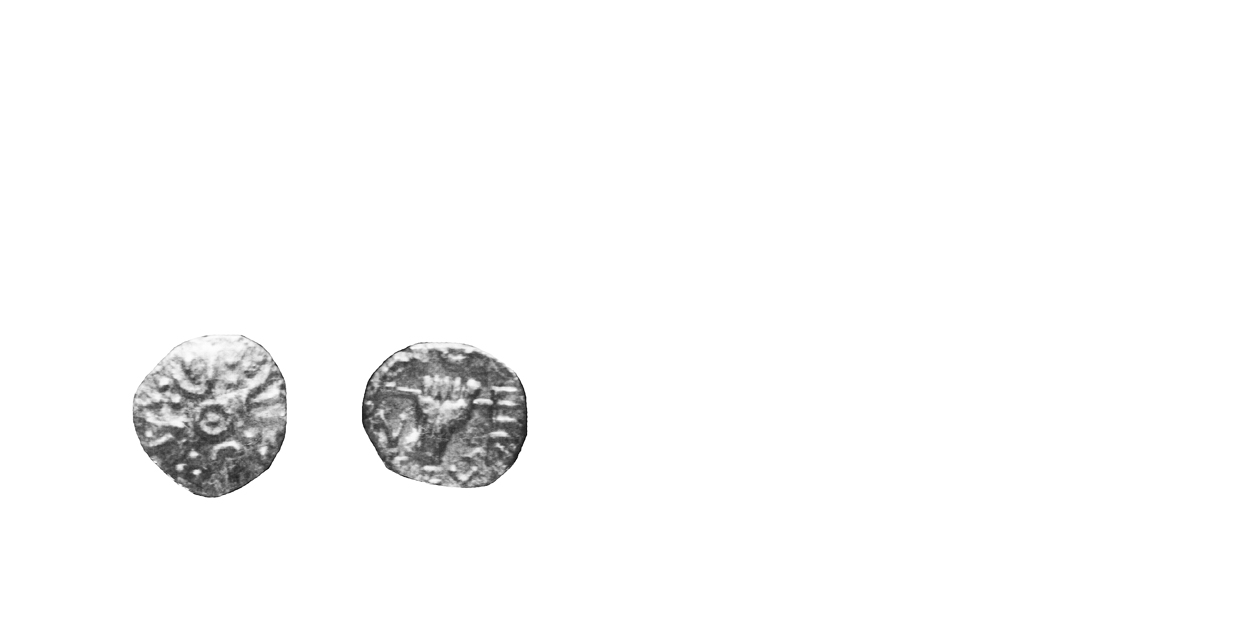
487 - 01 Verica First Coinage
10-20 A.D. Extremely Rare
Silver Minim 8 mm
Earliest Record: Van Arsdell, 1989
OBV: Geometric pattern
Identifying points:
1) pellet-in-ring motif in centre
2) four crescents around pellet-in-ring motif
3) line inside each crescent
4) three pellets between crescents
REV: Hand holding trident
Identifying points:
1) V R on sides of hand
2) EX below hand
3) crescent above hand
CLASSIFICATION: Atrebatic I
NOTES:
- Most in museums
- Coin has not been authenticated via metallurgical analysis but appears to be plausible type
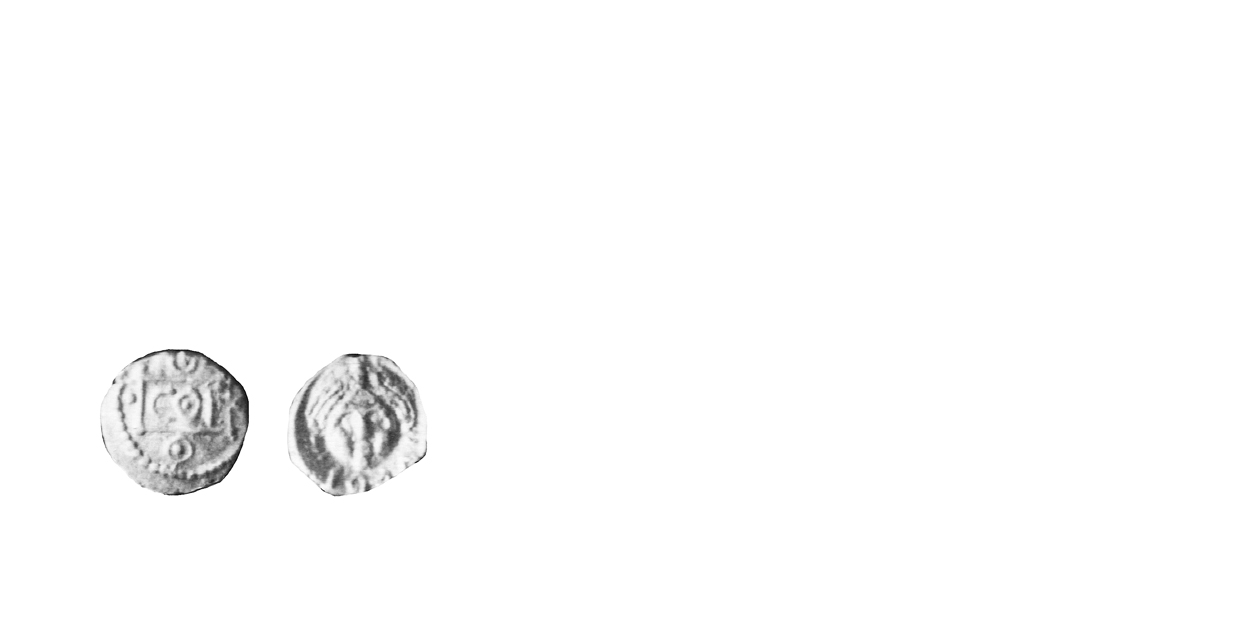
488 - 01 Verica First Coinage
25-20 B.C. Extremely Rare
Silver Minim 0.24 gms. 7 mm
Earliest Record: Van Arsdell, 1989
OBV: Box
Identifying points:
1) C and F separated by pellet-in-ring motif inside box
2) pellet on either side of box
3) pellet-in-ring motif above and below box
4) pellet border
REV: Facing Medusa
Identifying points:
1) straight hair
2) legend VERICA
CLASSIFICATION: Atrebatic I
NOTES:
- Most in museums
- Coin has not been authenticated via metallurgical analysis but appears to be a plausible type
- This type had initially been attributed to Tincommius (384 -01), with an illegible reverse legend, however a better-preserved example now shows the legend to be VERICA
480 - 01 Verica First Coinage
10-20 A.D. Extremely Rare
Silver Minim
Earliest Record: Van Arsdell, 1989
OBV: Head right
Identifying points:
1) head bear
REV: Horse right
Identifying points:
1) VIRI above horse
2) CO below horse
CLASSIFICATION: Atrebatic I
NOTES:
- Not illustrated
- Initial reports of many finds at Wanborough cannot be verified
- Celtic Coin Index records now indicate rarer than originally thought
Coinage of the Atrebates, Regni & Belgae
The Atrebates, Regni and Belgae occupied the territory that is today Berkshire, Sussex and Hampshire. Whether three distinct political groups struck coins cannot be proven today, nor can separate territories be demonstrated. The Regni are virtually unknown to history until the Roman period, and the tribal area of the Belgae is a matter of controversy. Though Belgic immigration is mentioned by Caesar, he does not specifically say where they settled, and we only have the Roman name Venta Belgarum to suggest a location. The Atrebates, also mentioned by Caesar, had tribal members on both sides of the Channel.
Traditionally, the three tribes have been treated numismatically as one. Based on the current state of research, there is no reason to change this approach. Attempts have been made to identify a separate coinage for the Belgae. These have been largely, but not entirely, based on reports of new types of silver coins published in numismatic trade lists since 1994. The coins do not appear to form a coherent issue of a single issuing authority and questions exist regarding their precise status. These enigmatic coins demand careful analysis and reflection before they are accepted as evidence for a Belgic coinage. Certainly, after the Gallic War, only one coinage circulated in the territory. It may someday come to pass that coinages for the Belgae and Regni can be identified, but only after a rigorous analysis of the new types has been completed. Most of these are listed under "New Material". For the remainder of this discussion the three tribes will be referred to simply as the "Atrebates" for the sake of brevity.
Initially, the three tribes constituted one of the most advanced groups in Britain. They had trading contacts with Belgic Gaul in the late second and early first centuries B.C., and were one of the earliest to strike coins. The earliest stater, the INSULAR TYPE struck before the Gallic War, is derived from imported Gallo-Belgic C. The next coinage, the WESTERHAM TYPE, is now felt to be inspired by the Trinovantian/Catuvellaunian coinage of the same name, struck during the Gallic War. After the war, the tribal position changed dramatically, and the Atrebates may have fallen out of favour with the Romans. It is possible the cross-Channel trading rights were given to the Trinovantes/Catuvellauni instead. A loss of trading rights may have been the result of Commius' activities during the War.
Commius, at first a supporter of Caesar, became disillusioned with the Romans and went over to Vercingetorix. After the collapse of Celtic resistance at Alesia, he fled to join the British part of his tribe. Later, the Atrebates struck coins with his name, and possibly the acceptance of Commius in Britain was the reason they fell out of favour. The change in trading rights altered the relative fortunes of the two tribes forever. By the end of the millennium, the Trinovantes/Catuvellauni had economic influence throughout southern Britain and had begun to rival the Atrebates.
The Atrebates seized the opportunity of the Trinovantian/Catuvellaunian Interregnum to mount a military incursion into Kent under their leader, Eppillus. Eppillus struck a victory stater commemorating the initial success of the expedition. The incursion was cut short, however, by the elevation of Cunobeline to the Trinovantian/Catuvellaunian throne. He drove the Atrebates out of Kent and Eppillus promptly disappeared. He is replaced on the coins by Verica, a self-styled 'son of Commius'.
Sometime before the Claudian invasion, Verica was in turn overthrown. He probably was the historical Celtic leader 'Bericus' who appeared in Rome seeking aid from Claudius. Verica was replaced on the coins by Epaticcus, who styled himself a 'son of Tasciovanus'. Whether the family-tie was real is not so important, the result was the Atrebatic leadership was now held by a Trinovantian/Catuvellaunian sympathizer. Shortly before the Claudian invasion, Epaticcus was replaced by Caratacus, the famous leader of the British resistance against the Roman invaders. The Atrebatic coinage came to an end during the forties, as Caratacus fled westwards to lead the resistance amongst the tribes in Wales. One Atrebatic leader known to history, Cogidubnus, has not yet been identified on the coinage. It seems he was not elevated to leadership until the coinage had come to an end.
The oppidum of Calleva, Silchester today, was the site of an Atrebatic mint, and the name Calleva appears on coins of Eppillus. Other leaders may have had mints elsewhere, but none have been identified. Plausible mint sites for separate Belgic or Regnan coinages have not been identified.
